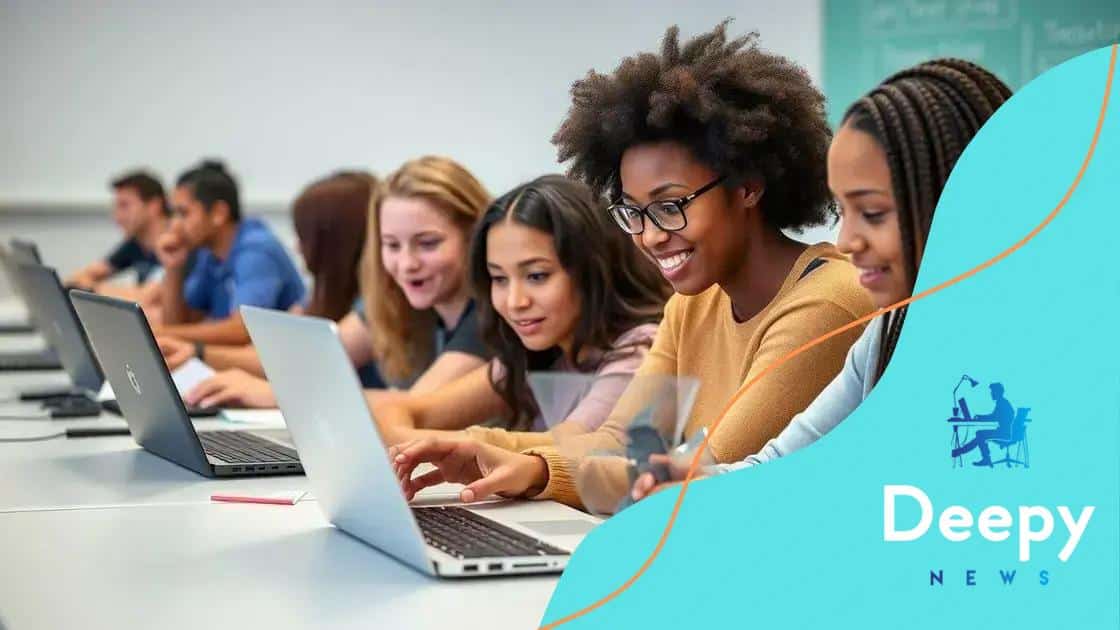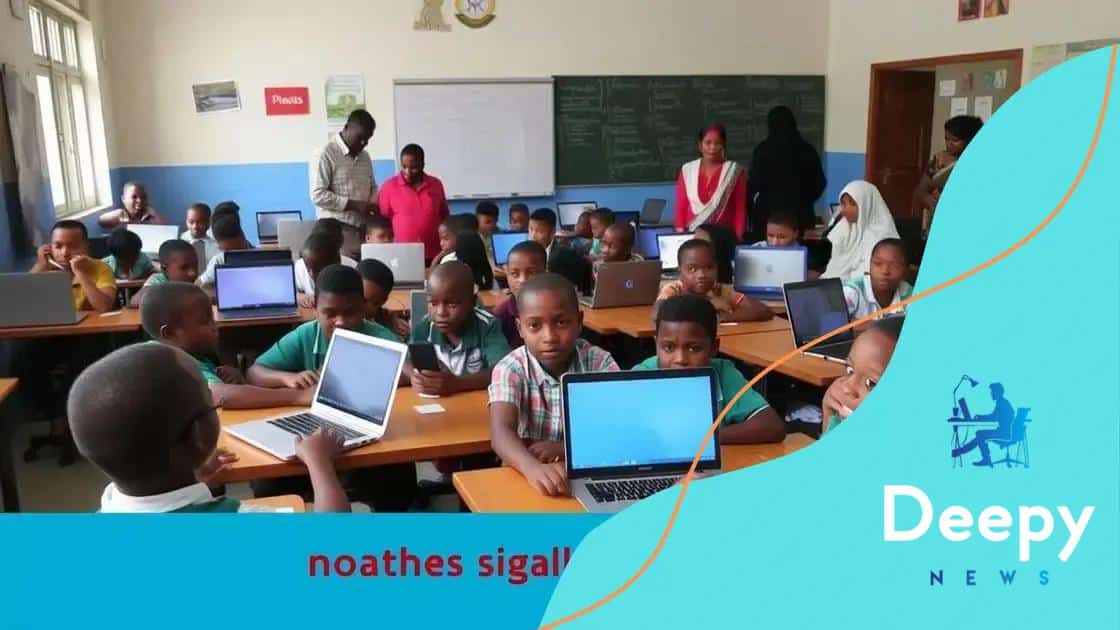Addressing equity in access to digital education: A necessary breakthrough

Addressing equity in access to digital education involves ensuring all students can access resources, technology, and opportunities, thereby reducing barriers and promoting inclusive learning environments for every learner.
Addressing equity in access to digital education is essential for ensuring that every learner has the opportunity to succeed. Have you considered how unequal access impacts students in your community? Let’s dive into this topic and explore actionable solutions.
Understanding digital education equity
Understanding digital education equity is vital in today’s learning landscape. It ensures that every student has access to the necessary resources for their educational journey. This approach not only enhances learning opportunities but also fosters inclusivity.
What is Digital Education Equity?
Digital education equity refers to the fair distribution of digital resources and opportunities among all students, regardless of their background. It encompasses access to technology, internet connectivity, and quality educational content. By achieving equity, we ensure that all learners can thrive.
Key Elements of Digital Education Equity
- Access to Technology: Every student should have access to the devices they need, such as computers and tablets.
- Internet Connectivity: Reliable internet access is crucial for effective digital learning.
- Quality Educational Content: Resources must be relevant, engaging, and appropriate for all learners.
The lack of these elements can lead to significant gaps in knowledge and skills. Unfortunately, many students face barriers that prevent them from fully participating in digital education.
It is essential to recognize the various challenges that contribute to this inequality. Factors such as economic circumstances, geographic location, and educational policies play significant roles in shaping access to digital resources. By understanding these barriers, we can work towards creating solutions that promote equity.
Bridging the Gap
To bridge the gap, communities, educators, and policymakers must collaborate. Initiatives that focus on providing resources to underprivileged areas, training educators on digital tools, and fostering partnerships with technology companies can make a difference. It is also important to gather feedback from students and families to understand their needs better.
Ultimately, ensuring digital education equity is a collective responsibility. By taking action and advocating for equal access, we can pave the way for a more inclusive and effective educational environment for all learners.
Barriers to accessing digital education
Barriers to accessing digital education can greatly hinder a student’s ability to learn effectively. These challenges can arise from various factors, making it essential to identify and address them to promote equity.
Economic Challenges
One of the most significant barriers is economic inequality. Many families lack the financial resources to purchase necessary devices or pay for internet connectivity. This digital divide often leaves students with fewer opportunities to engage with educational content.
- High Costs: Devices and internet plans can be expensive, especially for low-income families.
- Lack of Funding: Schools in underfunded areas may struggle to provide necessary technology.
- Digital Literacy: Financial constraints can limit access to training on using technology effectively.
Geographic location also plays a role in creating barriers. Rural areas often suffer from a lack of infrastructure, leading to unreliable internet services. This makes it difficult for students in these regions to participate fully in online learning.
Technological Barriers
In addition to economic and geographic challenges, technological barriers can also impede access. Many students face issues related to outdated equipment or insufficient support for various digital platforms.
- Outdated Devices: Many students may have old computers or tablets that are not compatible with current learning software.
- Technical Support: Limited access to tech support can leave students struggling with technical difficulties.
- Software Accessibility: Certain educational tools may not be available on all devices.
Furthermore, social and cultural factors contribute to the barriers in accessing digital education. For instance, students from marginalized communities might face discrimination, which can affect their engagement and willingness to utilize available resources.
The combination of these barriers creates a complex landscape that challenges the pursuit of equitable digital education. It is crucial to analyze these obstacles carefully and seek ways to remove them to foster an inclusive learning environment for all.
Successful initiatives promoting digital inclusion

Successful initiatives promoting digital inclusion have emerged in various forms, aiming to bridge the gap and ensure that every student has access to digital education. These programs are designed to address the barriers identified earlier and make technology accessible to all.
Community Programs
Many communities have launched programs that provide devices and internet access to students in need. For example, local governments often partner with schools to provide laptops and tablets at reduced costs. This can help families that might not otherwise afford the technology necessary for learning.
- Device Donation Programs: Many organizations collect and refurbish old devices, ensuring they are functional for student use.
- Community Wi-Fi Initiatives: Some towns are creating free public Wi-Fi zones to help students connect to the internet.
- Tech Literacy Workshops: Offering training sessions to help families understand and utilize digital tools effectively.
Business partnerships also play a crucial role in enhancing digital inclusion. When companies team up with schools and educational organizations, they can provide resources and technology that transform learning experiences. These partnerships can lead to the creation of digital learning labs within schools, equipped with the latest tools and technologies.
Educational Grants and Funding
Grants aimed at increasing digital access have resulted in the development of innovative educational programs. These funds can support initiatives that target underserved communities, ensuring equitable access to technology resources.
By focusing on areas such as internet connectivity and device availability, grant programs can significantly impact students’ learning environments. Efforts like these show that investment in digital inclusion is essential for fostering a more equitable education system.
A number of nonprofits advocate for broader access to digital education. These organizations work tirelessly to raise awareness about the importance of technology in education and often provide direct support to students and schools in need.
Through collaboration between various stakeholders—schools, governments, businesses, and nonprofits—successful initiatives can pave the way for lasting change. By collectivizing efforts around digital inclusion, these programs contribute to creating an equitable learning experience.
The role of technology in bridging gaps
The role of technology in bridging gaps in digital education is crucial for creating equitable learning environments. By leveraging various technological tools, educators can address barriers that prevent students from accessing educational resources effectively.
Enhancing Learning Experiences
Technology enhances learning by providing diverse resources that cater to different learning styles. For instance, interactive platforms allow students to engage with content in ways that are stimulating and enjoyable. This means learners can absorb information better and develop skills at their own pace.
- Multimedia Tools: Using videos, podcasts, and interactive simulations can make complex topics easier to understand.
- Online Resources: Students can access a wealth of information and materials from anywhere, promoting self-directed learning.
- Gamification: Incorporating game-like elements into lessons can motivate students and improve retention.
Moreover, technology facilitates communication between educators, students, and families. Tools like learning management systems enable teachers to provide feedback and track progress effectively. This real-time interaction encourages a supportive learning environment, allowing for tailored educational experiences.
Building Connectivity
Technology is key in connecting underserved communities with educational opportunities. For instance, online learning platforms can reach students in remote areas where traditional schooling may not be feasible. By utilizing video conferencing and online resources, students can participate in high-quality lessons from anywhere.
In addition, collaborative tools help unite students from different backgrounds. These tools encourage teamwork and friendship, fostering a sense of community that enhances the learning experience. For example, platforms that allow group projects enable students to collaborate regardless of their location.
Overall, the integration of technology into education serves to bridge gaps that exist due to economic, geographic, and social disparities. By focusing on accessibility and inclusivity, we can create a level playing field where every student has the chance to succeed.
Future trends in educational equity
Future trends in educational equity are shaping the landscape of learning for students everywhere. As we look ahead, technology and innovative approaches promise to make education more inclusive and accessible for all students.
Personalized Learning
One significant trend is the move towards personalized learning experiences. With advances in technology, educators can tailor lessons to meet the unique needs of each student. This means that students who require additional support can receive just that, while others can advance at their own pace.
- Adaptive Learning Technologies: These tools adjust the content and pace of learning based on individual progress.
- Data-Driven Insights: Teachers can use data to identify where students struggle and adapt instruction accordingly.
- Flexible Learning Paths: Students can choose learning experiences that align with their interests and goals.
In addition to personalized learning, there is an increasing focus on the importance of social and emotional learning (SEL). By integrating SEL into educational practices, schools can help students develop essential skills like empathy, resilience, and teamwork. This holistic approach creates a more supportive environment that benefits all learners.
Increased Access to Resources
Another trend is the enhancement of access to educational resources. As online learning continues to expand, more students can benefit from high-quality content and instructional materials. Virtual classrooms and resources allow students from various backgrounds to engage with top-tier education that was once out of reach.
Collaborative initiatives between schools and technology companies also foster improved access. Partnerships can provide students with devices, internet access, and learning platforms that empower them to succeed.
As we embrace the future, focusing on educational equity will be essential. Policymakers and educators must work together to address disparities and implement innovative solutions that enhance learning for every student. By prioritizing equity, we can ensure that the benefits of education are shared by all.
In conclusion, addressing equity in access to digital education is vital for creating a just and inclusive learning environment. With targeted initiatives and the role of technology, we can reduce barriers and provide all students with equal opportunities. As we move forward, the focus on personalized learning, community collaboration, and resource accessibility will continue to shape the future of education. By prioritizing these areas, we can ensure that every student thrives, no matter their background. 🌟
FAQ – Frequently Asked Questions about Addressing Equity in Digital Education
What does equity in digital education mean?
Equity in digital education ensures that all students have equal access to resources, technology, and opportunities for learning.
How can technology help bridge the education gap?
Technology can enhance learning experiences through personalized content, increase resource accessibility, and facilitate communication among students and educators.
What role do community partnerships play in improving educational equity?
Community partnerships can provide necessary resources, support, and funding to help ensure that all students receive a quality education.
Why is personalized learning important for students?
Personalized learning caters to individual student needs, allowing them to learn at their own pace and engage more effectively with the content.






